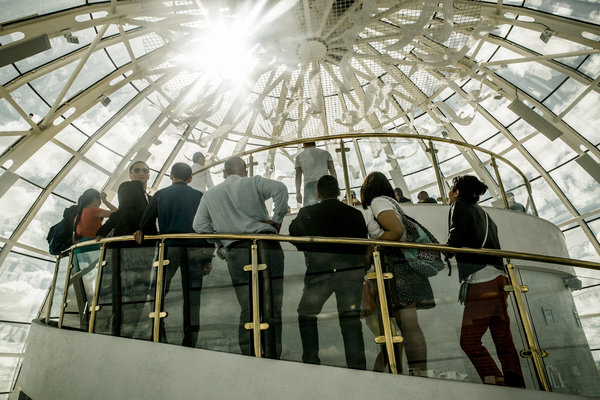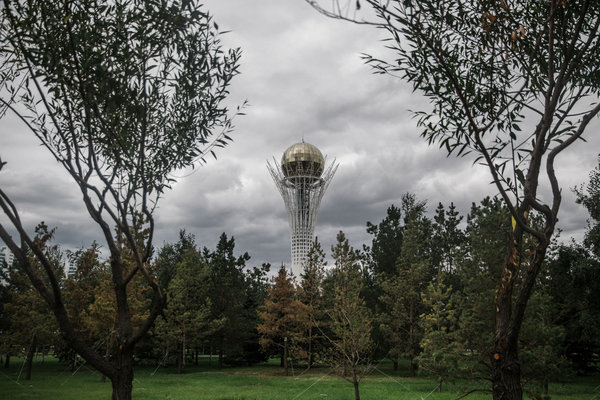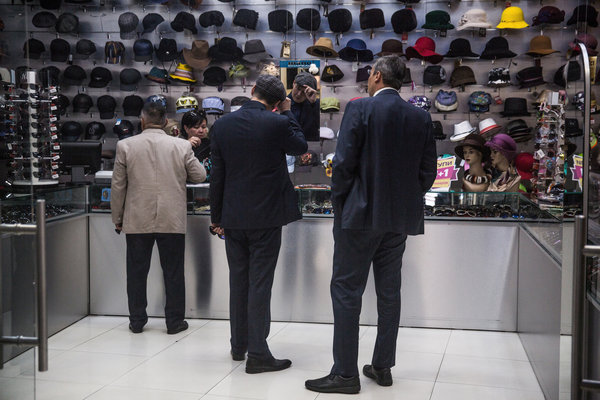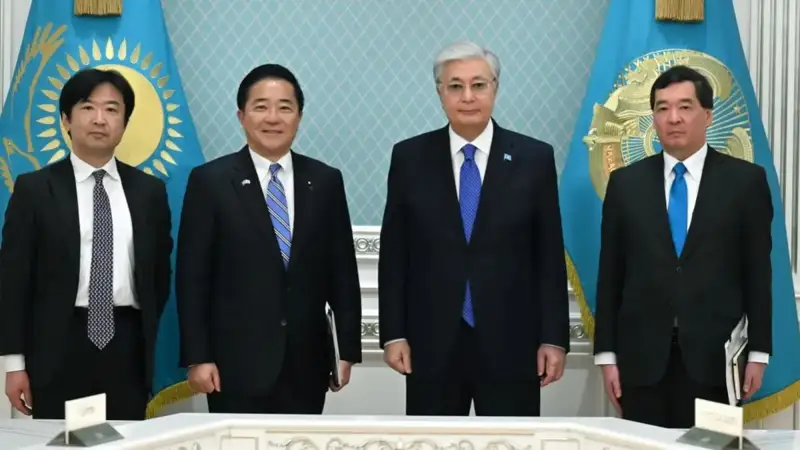 With Expo 2017, the former Soviet Republic is trying to wean itself from oil and create a new global financial hub.
With Expo 2017, the former Soviet Republic is trying to wean itself from oil and create a new global financial hub.
By day, the huge and gleaming sphere looks like the spaceship of aliens who may not have come in peace. At night, it blinks out a playful pattern of colors and boosterish slogans on its high-tech outer skin — a few parts light show, a few parts bumper sticker.
Known officially as the Nur Alem, the imposing silver globe is the symbol and centerpiece of Kazakhstan’s latest attempt at an “Open For Business” sign. Five years ago, the country won the rights to stage what is essentially the world’s largest science fair. More than 100 nations built pavilions on a once-empty corner of this capital city. The Kazakh government chipped in a reported $3 billion, and, after an 11th-hour, all-hands push, met a June 10 deadline to open Expo 2017.
The theme of the fair, which closes on Sunday, is “Future Energy.” That may sound like a stab at humor given that oil, gas and metals are the lifeblood of the country. But guided by the hand of Nursultan Nazarbayev, the first and, so far, only president of this former Soviet Republic, Kazakhstan is trying for a dramatic economic makeover.
 Five years ago, Kazakhstan won the rights to stage what is essentially the world’s largest science fair, where more than 100 nations built pavilions.
Five years ago, Kazakhstan won the rights to stage what is essentially the world’s largest science fair, where more than 100 nations built pavilions.
MAXIM BABENKO FOR THE NEW YORK TIMES
The country does not want to merely sell off state-owned assets. The goal is to wean the nation from a dependence on natural resources and to transform it into a financial hub, the Dubai of Central Asia. There are plans for a new stock exchange overseen by an independent judicial system. Tech start-ups will get the come-hither, too, with the hope of giving rise to Kazakhstan’s own version of Silicon Valley.
All of this will take foreign investors, and not enough of them have reached for their checkbooks yet. As a share of the country’s gross domestic product, net foreign investment has dropped to 3.5 percent, from a high of 13 percent in 2004, the World Bank reports.
Experts say that, despite talk of reform and transparency, Kazakhstan is still quietly controlled by shifting alliances among elites, all of them angling for prestige and riches in a soap opera scripted by the president. “You have to carefully assess who your Kazakh partners are and where they fit into the elite structure,” said Livia Paggi, a director at GPW, a political risk firm. “They can be bright and well connected, but if they fall out of political favor and lose their status, your business is at serious risk. In the worst case scenario, your asset could be seized.”
When Mr. Nazarbayev, 77, isn’t refereeing the never-ending tournament of clans, he is the nation’s stern and loving grandfather, a ruler whose style might be described as autocrat lite. He has many of the trappings of an old-school authoritarian, including a self-mythologizing museum, a spotty record on human rights and a glaring absence of genuine political opposition. The last time he ran for re-election, in 2015, he won 98 percent of the vote — a figure so high that he apologized the next day.
“But I could do nothing,” he said, during an Orwellian press conference at the time. “If I had intervened, I would have looked undemocratic, right?”
 The Bayterek Tower in Astana has a podium where visitors can place a hand over a golden mold of President Nursultan Nazarbayev’s palm.
The Bayterek Tower in Astana has a podium where visitors can place a hand over a golden mold of President Nursultan Nazarbayev’s palm.
MAXIM BABENKO FOR THE NEW YORK TIMES
Nonetheless, Mr. Nazarbayev has devoted much of his political life to expanding Kazakhstan’s middle class, which has grown from just 9 percent of the population in the mid-2000s to 33 percent in 2014, according to the World Bank. To his people and to investors, he offers both opportunity and stability — at least for now. He has never articulated a plan of succession, a pressing matter given what the actuarial tables would say about a man who toiled for years as a steelworker in Ukraine, breathing dust and gas near a blast furnace.
Then there is Kazakhstan’s branding problem. Although it is wedged between China and Russia and has a land mass roughly four times the state of Texas, few outside the commodities business could pin it on a map. It is forever lumped with the other “stans” in the neighborhood, which are repressive by comparison. Kazakhstan’s big international breakout moment came as the butt of jokes by comedian Sacha Baron Cohen, who played Borat, a bigoted and clueless Kazakh, in a 2006 mockumentary.
Expo 2017 is a splashy attempt to change that image. Kazakhstan beat out Belgium for the rights to host the “specialized expo,” essentially a slightly scaled-down world’s fair. Most of the visitors are tourists, but the key audience here are business executives, government leaders and anyone else who could sink real money into a country that is eager to diversify.
Much is riding on the event. Too much, perhaps, given that it is in a city as remote and singular as Astana and devoted to a subject as bland as “future energy.” How many Westerners packed up their families and said, “Let’s fly to Kazakhstan and learn about biomass fuel”?
Very few, judging from three days spent walking the grounds not long ago.
 Camels and other animals were among the sights to greet visitors to Astana.
Camels and other animals were among the sights to greet visitors to Astana.
MAXIM BABENKO FOR THE NEW YORK TIMES
Multimedia Infomercials
Most people enter Expo through the Mega Silk Way, a 1.5 million-square-foot mall. It is filled with Kazakhstan’s answers to Western staples: a restaurant that looks like Applebee’s, a computer retailer that resembles an Apple store. Anyone yearning for local flavor can dine at Rumi, with traditional decorations on the walls and horse meat on the menu.
The fairgrounds look pristine, and touring the premises is like strolling through an updated United Nations as reimagined by a big box retailer. Many countries used their pavilions for elaborate, multimedia infomercials. Vietnam promoted its economy, Georgia extolled its wine and Belarus went for a hard-core real estate spiel, pitching a huge industrial park it is building with the Chinese.
In an effort to appear environmentally minded, Saudi Arabia showed a film on an IMAX-size screen with a montage that included men drinking bottled water and the words, “We sustain.” Thailand highlighted the energy uses of animal waste, with the life-size rear end of an animatronic elephant, complete with a waggling tail, hovering over a convincing reproduction of a large dung patty.
“No step,” an unnecessary sign nearby said.
For sheer production values, Russia’s pavilion was hard to beat, although it was essentially a long claim to the rights to mine natural resources in the Arctic — something that seemed wildly tin-eared in this setting. The country even displayed a block of “old arctic ice,” which, after watching films of melting floes all over Expo, made you want to yell, “Put it back!”
 Visitors to the Thailand pavilion at Expo 2017 watched a 3-D video cartoon.
Visitors to the Thailand pavilion at Expo 2017 watched a 3-D video cartoon.
MAXIM BABENKO FOR THE NEW YORK TIMES
 Visitors to Saudi Arabia’s pavilion wore national costumes while taking photos.
Visitors to Saudi Arabia’s pavilion wore national costumes while taking photos.
MAXIM BABENKO FOR THE NEW YORK TIMES
The true ambitions behind Expo will only become apparent after it ends. The plan is to transform several of the buildings into Kazakhstan’s Wall Street. The main attraction of the Astana International Financial Centre will be a stock exchange, created in partnership with Nasdaq, and a legal center for addressing financial disputes, to be governed by British common law.
The financial center goes beyond what has been tried here before. But Kazakhstan already has a stock exchange, and it has talked about selling off a greater share of state-owned assets in the past. To foreign investors, this new plan sounds very familiar. What has changed, government officials say, is the context.
“When the price of oil was $100 a barrel, it was difficult to convince anyone to think another way,” said Kairat Kelimbetov, governor of the financial center. “The price of oil is $50 a barrel, and we don’t think it is ever coming back. Now is the time to wake up.”
For years, Kazakhstan had a terrible case of the resource curse, Mr. Kelimbetov said, referring to the paradoxical plague of the easy money that can come to any country with fortunes that are simply buried in the ground. But the curse is over here, and so far, that has brought only new curses.
After growing for years, Kazakhstan’s middle class is shrinking, and the poverty rate has inched close to 20 percent, up from 16 percent in 2014, a World Bank report says. Average monthly wages, which now equal about $421, have fallen slightly for two years straight.
 After growing for years, Kazakhstan’s middle class is shrinking, and the poverty rate has inched close to 20 percent.
After growing for years, Kazakhstan’s middle class is shrinking, and the poverty rate has inched close to 20 percent.
MAXIM BABENKO FOR THE NEW YORK TIMES
A series of sudden drops in the value of the Kazakh currency, the tenge, helped drive the inflation rate to 14 percent last year and added to the pain. The worst of the drops occurred in 2015, after the country’s central bank introduced a free floating exchange rate. The tenge fell 25 percent against the dollar in a single day.
For an economy that soared by 13 percent soon after the turn of the century, the 1 percent rise in G.D.P. last year was a dismal comedown. The problem is that Kazakhstan remains addicted to oil and gas, which now account for nearly 60 percent of all exported goods and services. Sanctions against Russia, which has long been Kazakhstan’s main trading partner, have hurt too.
The country has hired advisers, including Tony Blair Associates, the consulting firm led by the former British prime minister, to reform its economy and make it more welcoming to Western investors. On paper, the efforts have paid off: The country rose 16 spots, to 35th in world, in one year on the World Bank’s annual Ease of Doing Business rankings.
Other lists are less flattering to Kazakhstan: It tied with Russia for 131st on Transparency International’s Corruption Perceptions Index. The problem goes well beyond perceptions, as Expo 2017 itself demonstrated. The man initially in charge of the project, Talgat Ermegiyayev, was arrested in 2015, and then tried and convicted of embezzlement. The case startled the public, in part because Mr. Ermegiyayev’s family had a long personal relationship and business ties to the president and his children.
 The Bayterek Tower has been nicknamed Chupa Chups because of its resemblance to a lollipop.
The Bayterek Tower has been nicknamed Chupa Chups because of its resemblance to a lollipop.
MAXIM BABENKO FOR THE NEW YORK TIMES
The case looked, to all the world, like a crackdown, and proof that Mr. Nazarbayev would no longer tolerate impropriety, even by insiders. But little about Kazakhstan’s gilded clans is straightforward.
Vera Kobalia, Expo’s former deputy chairwoman, said in an interview that the public account of Mr. Ermegiyayev’s fall was a charade. Reached by phone at her new job in Indonesia, she said that Mr. Ermegiyayev’s troubles began when an executive from a music channel in Russia asked Expo to advertise and sponsor an awards show.
Nyet, said Expo staff members. The marketing budget had already been entirely allocated.
So the Russian executive called a member of the president’s inner circle, who then called Expo employees, Ms. Kobalia said. Mr. Ermegiyayev had no choice. The twist is that the deal with the music channel was used against Mr. Ermegiyayev at his embezzlement trial.
“Ermegiyayev was really a scapegoat to write off the funds that disappeared during the first phase of construction of Expo,” said Ms. Kobalia, a former minister of the economy in Georgia, who quit her job at Expo after little more than a month. “I personally told him to speak openly in the court or to journalists about everything he knew, but he believed until the last minute that the president would save him.”
Novelty and Scale
The bold, attention-seeking gesture that is Expo is actually dwarfed by the bold, attention-seeking city where Expo is being held. Astana is Mr. Nazarbayev’s most improbable creation. In 1994, he announced that the nation’s capital would move 755 miles north from its original seat, Almaty, a city dense with history, culture and people.
The decision seemed ludicrous at first. Before bureaucrats started to relocate in droves, Astana was a crumbling outpost in the middle of the windswept steppe, swarming with mosquitoes in the summer and a tormenting 20 degrees below zero for much of the winter. There was one hotel and one restaurant.
 A pool in a mall is a round-the-year escape from Astana’s otherwise harsh climate.
A pool in a mall is a round-the-year escape from Astana’s otherwise harsh climate.
MAXIM BABENKO FOR THE NEW YORK TIMES
Construction has yet to end, and clearly, the subtle charm of a walkable metropolis is not to Mr. Nazarbayev’s taste. He likes his streets wide and his buildings striking, ornate and spread around like they fell off a Monopoly board. Some look like they have been collected, souvenir-style, from all over the world. You drive down a street and think: That looks just like the home of the Bolshoi Ballet.
“That’s exactly what it is,” a guide explains.
More specifically, it is a rendering of the original in Moscow, repurposed for the nearly 700,000-square-foot Astana Opera House. Moscow also inspired the neo-Stalinist Triumph Astana, home to offices, shops and apartments and a dead ringer for the Triumph Palace in Moscow.
Elsewhere, there are structures fashioned after Chinese pagodas, Indian mausoleums, Ottoman mosques and the pyramids of Egypt. The white marble presidential palace looks like the White House, if the White House had a blue dome and were set in an industrial park.
 The Astana opera hall.
The Astana opera hall.
MAXIM BABENKO FOR THE NEW YORK TIMES

Dancers preparing to perform.
MAXIM BABENKO FOR THE NEW YORK TIMES
For sheer quirkiness, nothing touches the 350-foot Bayterek Tower, which local residents have nicknamed Chupa Chups because of its resemblance to a lollipop. It offers a panoramic view of Astana and a podium where visitors can place a hand over a golden mold of Mr. Nazarbayev’s meaty palm. For a time, upon contact, Kazakhstan’s national anthem would suddenly blast from loudspeakers, at a volume loud enough to make people wonder if they had been punked.
Astana is what you get when a city builder with money to spare tries desperately to wow through novelty and scale. Or maybe it is an effort to compensate for Kazakhstan’s years of obscurity, when the czars of Imperial Russia, and then the premiers of the Soviet Union, all but sealed this place off from the world.
A few of the empire’s most famous undesirables spent part of their exile here: Fyodor Dostoyevsky after he ticked offNicholas I, and Aleksandr Solzhenitsyn after he ticked off Stalin. When it wasn’t used for state-mandated timeouts, Kazakhstan was the Soviet Union’s location of choice for outsize Cold War projects. Most lethally, it was where nuclear weapons were tested by the dozens, with shockingly little regard for basic safeguards, like evacuating residents.
When Kazakhstan achieved independence, in 1991, it aspired to create a presidential democracy based on the French model. But Mr. Nazarbayev, who rose to power through the Soviet ranks, has always seemed to have one foot in the system that created him and another in a system he hopes to create.
 A boy praying at the Khazret Sultan mosque in Astana. About 70 percent of Kazakhs are Muslims, and there are gorgeous mosques all over Astana.
A boy praying at the Khazret Sultan mosque in Astana. About 70 percent of Kazakhs are Muslims, and there are gorgeous mosques all over Astana.
MAXIM BABENKO FOR THE NEW YORK TIMES
On the positive side, the Nazarbayev era has been relatively free of ethnic or religious strife. About 70 percent of Kazakhs are Muslims, and there are gorgeous mosques all over Astana. But the country is officially secular. A high premium is placed here on tolerance.
The influence of the Soviet system shines through in discussions about who will govern next, understandably a topic of constant speculation. Occasionally, names of potential successors are floated in the newspaper: A daughter! A nephew! A mayor! Whether these are legitimate candidates or people being backstabbed by rivals is unclear. It is no secret that Mr. Nazarbayev punishes anyone he believes is vying for his chair.
He has also nurtured the sort of cult of personality that crops up only around despots. If that cult has a headquarters it is the Museum of the First President of the Republic of Kazakhstan, a building stuffed with more than 40,000 objects from Mr. Nazarbayev’s life. One room is devoted to his nomadic, horseback riding ancestors. Less is said about his father, a shepherd.
Plenty of Kazakhs roll their eyes at all of this. But the question here is always, “Compared to what?” Compared to Turkmenistan, this country is free and prosperous. Compared to France, it is not.
To Westerners, the economy has long seemed like a casino where the games are mostly rigged. Ten to 20 alliances control every financial venture worth backing. The trick is getting their attention.
“This is a country where everything is possible,” veterans of business here like to say, “and everything is impossible.”
Promises for Capitalism
While tourists traipsed through pavilions, a parallel Expo was unfolding above their heads. The second floor of many of the buildings were hosting panel discussions that doubled as schmoozing opportunities. An event titled “Transforming the Financial Services of Kazakhstan” was held one afternoon in a conference room above Britain’s pavilion. An audience of about 20 men and women in suits listened to upbeat projections about how Kazakhstan could become the financial technology center of a new Silk Road.
 Elevators at the Expo, where the theme was “Future Energy.”
Elevators at the Expo, where the theme was “Future Energy.”
MAXIM BABENKO FOR THE NEW YORK TIMES
The only skeptical note came from an earnest young man named Bekarys Nurumbetov, who is leads the marketing department of Kazakhtelecom, the nation’s phone and broadband goliath. After the session, he explained why he was not buying all the happy talk.
“There are no financial tech companies entering Kazakhstan,” he said, sipping bottled water over a plate of canapés. “They’re not interested in a business with low margins and high cost and competing with banks that are supported by the government.”
The problem is not corruption. “The government is O.K. with the way things are now,” Mr. Nurumbetov explained. “And the banks don’t want change because they don’t want to lose market share.”
Banks don’t trust consumers, he continued, and consumers don’t trust credit cards. So e-commerce companies, for example, face high and baffling hurdles.
Consider the case of Lamoda, a website that sells high-end fashion. When Alexios Shaw helped start it in 2011, he did not need just good-quality clothing and an efficient warehouse. He needed 100 couriers across the country to deliver products — and to make change.
“It was a cash on delivery business,” Mr. Shaw said. “Instead of paying in advance with a credit card, everyone paid with cash. You can’t use FedEx or the post office and leave a box at the door.”
 A store at the Khan Shatyr Entertainment Center.
A store at the Khan Shatyr Entertainment Center.
MAXIM BABENKO FOR THE NEW YORK TIMES
Delivering pants the same way that Domino’s delivers pizza is a challenge. Couriers end up with thousands of dollars worth of bills at day’s end, a logistical hassle beyond the issue of trust. Just as bad, customers try on clothing while couriers wait and hand back what they don’t want. That is not simply time consuming.
“The biggest problem was having a ton of goods out of stock,” Mr. Shaw said. “A lot of inventory was just sort of flying around Siberia.”
Several conversations like this reveal the vast gap between the country as it is now marketed and the country as it actually functions. Which is why Expo brings to mind another of the Soviet Union’s grandiose schemes for Kazakhstan: the Virgin Lands Campaign.
It began in the mid-1950s, when Nikita Khrushchev decided the steppe here could produce enough corn and wheat to match the production of the United States. Millions of acres were sown by hundreds of thousands of workers who poured in from Russia and Ukraine.
Kazakhs could have told their maximum leader that his dreams were doomed. This northern region of Kazakhstan has long been called Akmola, which translates to “white grave,” a reference to the hard and chalky ground beneath the earth’s crust.
The Virgin Lands Campaign found Kazakhstan’s agrarian limits. Expo and its aftermath promise to do the same for capitalism. It will be a challenge, say foreigners here, as tough as the soil. The Triumph Astana, home to offices, shops and apartments, closely resembles the Triumph Palace in Moscow.
The Triumph Astana, home to offices, shops and apartments, closely resembles the Triumph Palace in Moscow.
MAXIM BABENKO FOR THE NEW YORK TIMES
The New York Times, 09.09.2017




